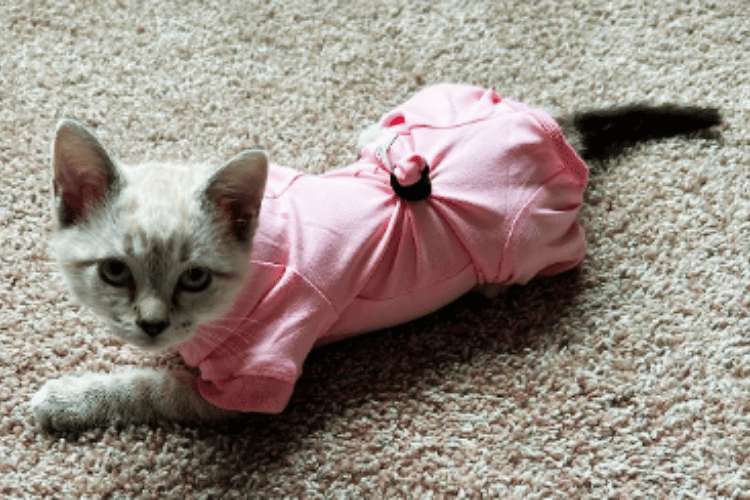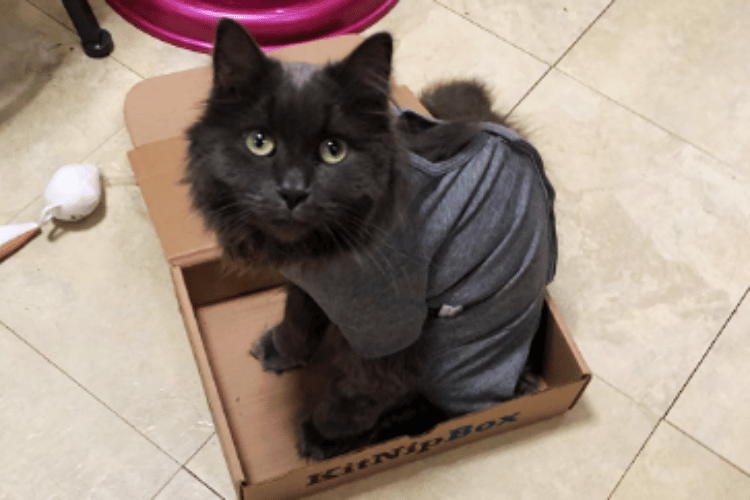As a pet owner, you may have wondered about the duration that a cat can safely wear a surgical onesie. This concern becomes even more pressing if your furry friend requires post-surgery care or has an injury that requires such a garment.
In this article, we'll delve into the ins and outs of how long you can keep a cat in a surgical onesie. Explore the various aspects of this topic, covering the recommended duration of wear, the ideal fabric choices, and factors to consider when choosing the right size.
With our expert insights, you'll learn how to keep your feline companion comfortable and healthy while they recover. So, let's dive in!

The Benefits and Limitations of Using a Surgical Onesie for Cats
Surgical onesies are a popular medical garment used in veterinary medicine to keep cats safe and comfortable after undergoing surgery and to prevent them from biting or scratching their incisions.
These onesies come in different sizes and styles, and they are usually made of stretchy and breathable fabric that allows for proper circulation and mobility.
The main benefit of using a surgical onesie for cats is that it keeps them from licking and biting their incisions, which can lead to infection, irritation, and delayed healing. Covering the wound site also reduces the risk of contamination from external factors such as dirt, dust, or other animals.
In terms of how long you can keep a cat in a surgical onesie, it depends on the type of surgery and the cat's individual needs. Generally, most cats can wear a onesie for up to two weeks, provided that they are well-fitted, cleaned regularly, and don't show any signs of discomfort or irritation.
However, some cats may require longer or shorter periods depending on the severity of their surgery and their recovery progress.
It's important to note that while surgical onesies can provide significant benefits for cats, they also have some limitations. For instance, they may cause discomfort if they are too tight or restrictive, or if they rub against the cat's skin or wound site.
They may also impede the cat's ability to move freely and engage in normal activities such as jumping or climbing.
Moreover, surgical onesies should not be used as a substitute for proper wound care and medical supervision. It's important to follow your veterinarian's instructions for post-surgical care, including administering medication, monitoring the incision site, and scheduling follow-up visits.
In summary, surgical onesies can be a valuable tool in caring for cats after surgery, but they are not a one-size-fits-all solution.
The length of time a cat can wear a onesie depends on various factors, and it's important to monitor their comfort and recovery progress closely. Ultimately, proper wound care and supervision are crucial for ensuring a cat's full and speedy recovery.

FAQs Surgical Onesie for Cats
It can be hard to know how long you can keep a cat in a surgical onesie, especially when there are so many different types and sizes available.
You want to make sure your cat is comfortable and safe, but you don't want to keep them in the onesie for too long. How long is too long?
We've compiled a list of the most frequently asked questions about keeping cats in surgical onesies so you can know more about these garments.
What is a surgical onesie, and when should you use it for your cat?
A surgical onesie is a specially designed garment made to help cats recover from surgery or injuries. It provides comfort and protection by covering the surgical site and preventing your cat from licking, biting, or scratching it. You should use a surgical onesie for your cat after surgical procedures, such as spaying/neutering, wound closures, or abdominal surgeries.
Can cats wear a surgical onesie for extended periods, or should it be removed after surgery?
Surgical onesies are designed to be worn for extended periods during your cat's recovery. It is recommended to keep the onesie on until the surgical site has fully healed, as determined by your veterinarian. However, it's essential to regularly check the surgical site for any signs of infection or irritation. If you notice any concerns, consult your vet for guidance.
How often should you clean the surgical onesie, and what's the best way to do it?
Cleaning the surgical onesie is crucial to maintain hygiene and prevent any discomfort for your cat. It's recommended to clean the onesie regularly, ideally every 2-3 days or as needed. To clean it, gently remove any loose fur or debris, and then hand wash it in lukewarm water using a mild detergent. Rinse thoroughly and allow it to air dry. Avoid using harsh chemicals or bleach as they may irritate your cat's skin.
Can cats move comfortably in a onesie while recovering from surgery?
Yes, cats can move quite comfortably in a surgical onesie. The onesie is designed to allow freedom of movement while keeping the surgical area protected. However, it's common for cats to take some time adjusting to wearing the onesie initially. To help your cat get accustomed to it, introduce the onesie gradually and provide positive reinforcement, such as treats and praise. Keep an eye on your cat's mobility and behavior to ensure they are comfortable.
Are surgical onesies a suitable alternative to traditional cones?
Yes, surgical onesies are a suitable alternative to traditional cones for many cats. Unlike cones, onesies can provide a more comfortable and less restrictive option for post-surgery recovery. They prevent your cat from directly accessing the surgical site, reducing the risk of complications, while allowing them to move around more freely. However, every cat is unique, and their specific needs may vary. It's always advisable to consult with your veterinarian to determine the most appropriate option for your cat's recovery.
In summary, surgical onesies can be a great way to keep your cat from licking or scratching at their wounds. However, it's important to monitor your pet closely and remove the onesie as soon as the wound has healed.
Generally speaking, it's best to keep a cat in a surgical onesie for no more than two weeks. After that, it's time to switch to a more comfortable garment and let your furry friend enjoy the freedom of moving around freely.
Remember, it's always best to talk to your vet if you have any questions or concerns about your cat's recovery. With the right care and attention, your pet will be back to their old self in no time!
Thank you for visiting LegitLists we hope this helps you make a legitimate choice!






